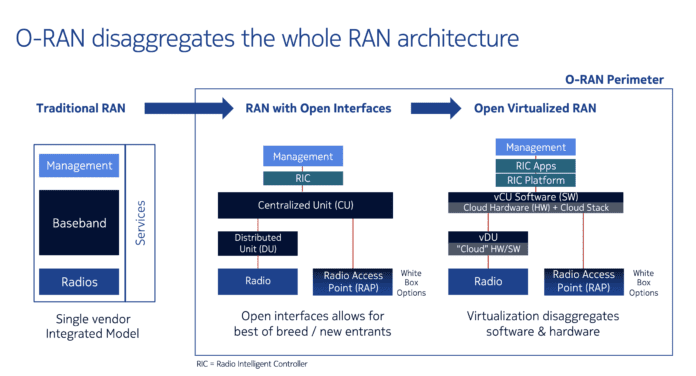5G is meant to be flexible so its radio access network should be too
Nokia is unique compared to its competitors Ericsson and Huawei in that the company has amped up messaging around open RAN generally and, specifically, its role in balancing open, interoperable interfaces with the elevated performance of tight integration. Similarly, Nokia has joined the new Open RAN Policy Coalition in an effort to engage with lawmakers around R&D funding and other market-based moves that could increase global competition with Huawei.
Corporate CTO and President of Nokia Bell Labs Marcus Weldon laid out four options that represent different degrees of openness and integration–platform component microservices, dynamic web services, bespoke platform services and guaranteed performance systems.
“Not all openness is good and not all closed-ness is good,” he said. “And equally, not always is it necessary to be highly integrated and in many cases it’s good to be more loosely integrated and dynamically interworked. Maybe where we should be aiming…is somewhere in the middle.”
He said all four are valid models and that many high-performance telecom systems sit in the top left quadrant. “I think of this as open and integrated,” in that integrated modules are connected to one another via open interfaces. As operators strategize in an effort “to find the bullseye in the middle” Weldon’s advice is to “integrate what you have to and open what you can.”
Weldon said there’s already significant openness between the radio and handset. “Those are open interfaces that are all specified in 3GPP…and everything works.” In the core, there’s historically a large degree of openness around things like routing and policy management. “That was a different set of ecosystem players that provided that so, again, a lot of openness there between the core and the RAN.”
So the radio access network is bookended by relative open, interoperable systems. So why has the focus shifted to the RAN? Variability in 5G service requirements, Weldon said. If operators want to address vertical-specific use cases with 5G, “I think that requires a whole host of different configurations of a radio access network in a 5G world which means I need more choice.”
Weldon continued: “We saw in the 5G era this degree of flexibility and cloud-nativity…in terms of infrastructure on which you build the solution whether it’s the software on a general purpose processor or the hardware on a hardware-accelerated cloud-native-type component. we saw that as the way to build future networks.”
Running through the points of interoperability in an open RAN architecture, Weldon called out interfaces between:
- Radio and the DU
- DU and CU
- CU and RAN Intelligent Controller (RIC)
- CU and Radio Access Point (RAP)
The move to open RAN also raises questions around the role of virtualized RAN, which is a key part of network slicing and the enterprise monetization opportunities that come with that capability. But, “Nothing comes for free. With all that openness we need to maintain tight interoperability for the highest performance to be met. In summary, it’s a potentially bright new horizon for RAN with a much more innovative set of capabilities driven by the need for 5G to be innovative and new value creating.”
Click here to view Weldon’s full presentation, moderated by Sandro Tavares, head of mobile networks marketing. And to hear Tavares discuss open RAN and other topics, listen to this recent episode of the podcast Will 5G Change the World? For even more on the promise of open RAN, as well as a look at attendant geopolitical issues, listen to this interview with Parallel Wireless CEO Steve Papa.

